Welcome to Bamberg! A city where time seems to stand still, yet every corner brims with life. Nestled in the heart of Bavaria, Germany, this UNESCO World Heritage Site is more than just a town; it’s a living, breathing museum, where each alleyway, building, and bridge has its own tale to whisper. From the serenity of the Regnitz river that divides it, to the majestic Bamberg Cathedral that watches over it, every step in this city feels like walking through the pages of a beautifully illustrated storybook.
Bamberg’s rich tapestry weaves together over a thousand years of history, visible in its remarkable architecture and preserved traditions. The Old Town, with its medieval layout virtually unchanged, invites you to wander and wonder at the sights like the Altes Rathaus, perched whimsically in the middle of a bridge. Here, history isn’t just something to be observed from behind a glass pane; it’s lived and breathed, a palpable presence in the bustling daily life of the city’s streets.
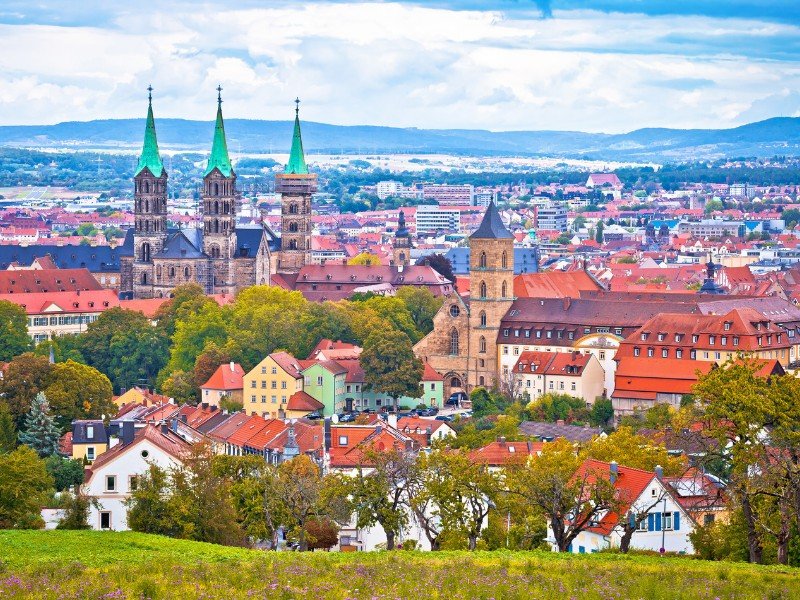
Beer, Gardens, and Everything in Between
No mention of Bamberg is complete without paying homage to its legendary beer culture. Home to more breweries per capita than any other city in the world, Bamberg takes its beer seriously, offering a diverse range from the unique smoked Rauchbier to refreshing lagers. And what better place to enjoy these than in one of the city’s many beer gardens, where locals and visitors alike gather under chestnut trees for a pint and a chat, embodying the Gemütlichkeit (coziness) that defines Bavarian culture.
Bamberg’s culinary scene is a delectable journey through Franconian cuisine, with hearty dishes that are as comforting as they are delicious. But it’s not just about the food; it’s about the experience – dining in centuries-old taverns or modern cafes that blend seamlessly into the city’s historic fabric. And as you meander from one culinary delight to the next, the cobblestone streets underfoot and the timber-framed buildings around you serve as constant reminders of the city’s enduring charm.
Bamberg’s Green Heart
Beyond its urban allure, Bamberg offers serene escapes into nature. The Hain Park, a sprawling green oasis along the Regnitz, provides a perfect backdrop for leisurely strolls or a quiet moment by the river. Here, the city’s love for the outdoors is evident, with families, cyclists, and joggers all finding their slice of tranquility.
Bamberg’s calendar is dotted with festivals that celebrate everything from its beer heritage to its religious and cultural history. The Sandkerwa, Bamberg’s annual folk festival, fills the streets with music, traditional food, and, of course, beer, drawing crowds from all corners of the globe. These festivals are not just events; they’re a testament to the city’s vibrant community spirit and its knack for throwing a great party.

Bamberg City Guide: A Brief History Of Bamberg, Bavaria
Bamberg emerges as a city frozen in time, cradling stories of emperors, episcopates, and epochs that have sculpted its streets and structures. It’s a journey through time, where the echoes of the past resonate through cobbled alleyways and ancient edifices.
Foundations and Empire
The Birth of Bamberg
The origins of Bamberg trace back to the 9th century, initially blossoming as a crucial junction on the Regnitz River. Its early significance was not just geographical but strategic, laying the groundwork for its ascent as a pivotal medieval metropolis.
Imperial Majesty
The turn of the first millennium marked Bamberg’s ascent to ecclesiastical prominence, under Emperor Henry II’s vision. In 1007, he founded the Bamberg Diocese, aiming to establish a northern Rome. The Bamberg Cathedral, a jewel of Romanesque architecture, encapsulates this era, standing as a solemn guardian of Henry II and Kunigunde’s final resting place.
Age of Enlightenment and Turbulence
The Beacon of Knowledge
The 17th century heralded the Age of Enlightenment, with the University of Bamberg’s establishment in 1647 igniting a cultural and intellectual renaissance. This era saw the city become a crucible of arts, science, and humanism, enriching its cultural fabric.
Shadows Over Bamberg
However, Bamberg’s narrative is also marred by darker chapters, notably the witch trials of the 17th century. This period saw fear and superstition culminate in tragic witch hunts, leaving a somber mark on its history.
Architectural Heritage and Modernity
A Fusion of Styles
Bamberg’s cityscape is a mosaic of architectural styles, from the Romanesque majesty of its cathedral to the baroque elegance of the New Residence. The Altes Rathaus, poised on its bridge over the Regnitz, epitomizes the city’s flair for the dramatic, with its frescoes and half-timbered façade.
The Legacy of Beer
Bamberg’s history is also steeped in the art of brewing, with its smoked beer (Rauchbier) tradition dating back centuries. Today, the city’s breweries continue to honor this legacy, inviting visitors to savor a taste of history.
Preservation and Prosperity
UNESCO Recognition
The city’s commitment to preserving its historical essence was internationally recognized in 1993 when Bamberg was inscribed as a UNESCO World Heritage Site. This honor celebrates Bamberg’s medieval layout and architectural heritage, ensuring its stories endure for future generations.
A Living History
Today, Bamberg stands as a vibrant testament to its past, where history and modernity coalesce harmoniously. It’s a place where one can wander through ages, exploring the depth of its heritage, the resilience of its people, and the enduring beauty of its natural and architectural landscapes.
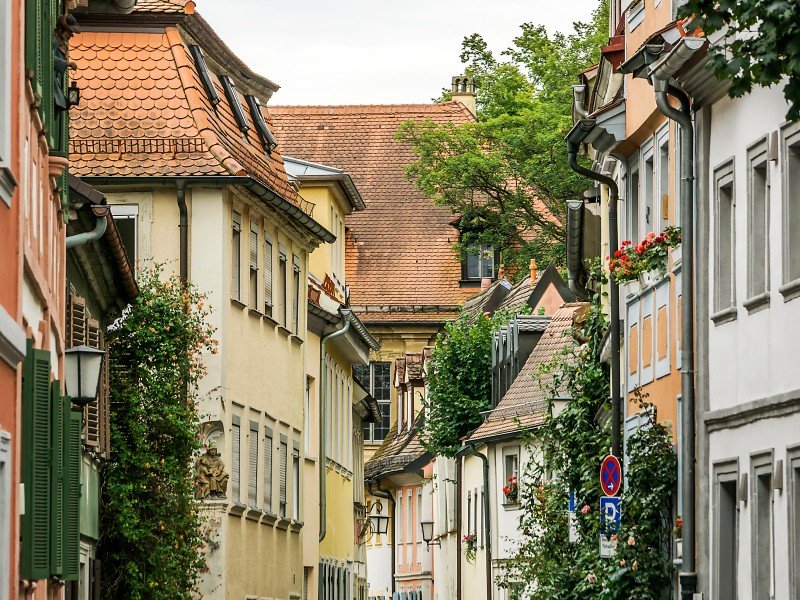
Bamberg Top Attractions and Best Places to Visit in Germany
Built on an island in the Regnitz River, Bamberg has a long history of trade and commerce. From its signature cathedral to its medieval town centre, plan on spending a few days here on your travels in Bavaria.
As alluded to in the intro, the Bamberg Cathedral is an impressive sight to see. This Romanesque/Gothic hall of worship has welcomed parishioners since the dawn of the 2nd Millennium. It was at that time when King Heinrich II commissioned its building.
As with many old churches, the original structure isn’t the one that has survived to see the present day. After burning a couple of times, authorities rebuilt the church, with the current iteration dating from the 13th century. Here, you’ll find the grave of Pope Clement II, as well as numerous works of art.
Like many other corners of Bavaria, you’ll find cool castles during your time in Bamberg. Make the Altenburg your first stop. Sitting atop the highest hill overlooking the city below, it served admirably in its defence since the 12th century.
More Attractions
Apart from that role, it also served as a prison during the 16th century. Today, it is more than a popular tourist attraction – you’ll also find a locally-beloved restaurant inside. While you can drive to this landmark, you can also reach via a 30-minute walk from town.
Neue Residenz Bamberg is another castle worth seeing during your visit to this corner of Bavaria. From the start of the 17th century, this palace served as the home of the Bamberg prince-bishops. While its art and architecture will impress, its rose garden steals the show with its beauty.
To make the most of your visit, opt for the guided tour. On it, a knowledgeable local will relay stories that will bring the things you see to life.
While in the Old Town, photographers should not miss the Altes Rathaus. Its exterior is worth a quick snap, but be sure to check out the frescoes and porcelain collection inside.
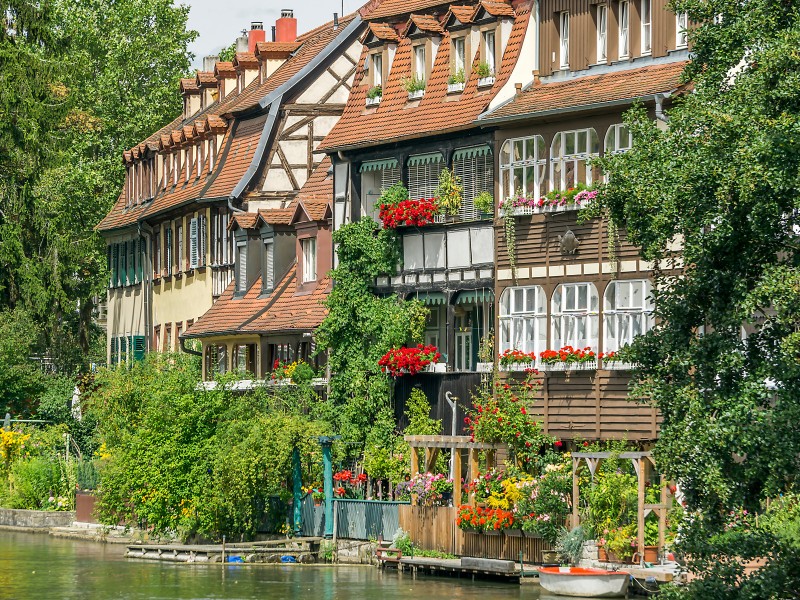
Other Cultural Attractions: Trip to Bamberg, Bavaria
If you have spare time during your time in Bamberg, drop by the Alte Hofhaltung. Located inside the Altes Rathaus, this museum contains art, pottery, and porcelain that once belonged to leading families in Bamberg.
Over the generations, repeated donations built up the collection that exists today. Apart from the highlights mentioned above, exhibits also show coins, astronomy tools, and clocks dating back to the 16th century. Tours are available, but the commentary is in German – if you can, bring a bilingual friend.
Still in the mood to check out museums? If so, make time for the Naturkunde-Museum of Bamberg. If you have kids, this is a wonderful place, as this institution takes a general approach to natural history. In particular, it focuses on fauna, with taxidermied animals and fossil displays being the highlight.
Like many attractions in Germany off-the-beaten-track, captions are in German only. Because of this, come with Google Translate queued up on your phone, or bring along a German-speaking friend. Note that curators charge an admission fee of 3.50 EUR.
More Attractions
If you’re into religious points of interest, take a trip to St. Martin’s Church. Unlike other churches in the city, this place is Bamberg’s only Baroque structure. Jesuits built this Christian hall of worship back in the 17th century.
Unlike other churches in Bamberg, this one flies under the radar. As a result, you can come here and be relatively certain of having a peaceful place to pray and reflect. Also, feel free to attend mass, as local parishioners welcome those from out-of-town to join them.
Spend your final hours in town enjoying the atmosphere of Bamberg Altstadt. Translating into English as the Bamberg Old Town, you’ll find medieval-style architecture at every turn. After getting in some sightseeing, find a cafe, get a coffee and watch the world go by.
While you are sat down at a pub in the Old Town of Bamberg, get yourself a spread of Obazda. This platter of cheese combines soft cheeses like Brie or Limburger with butter, onions, and paprika. Pair it with a pretzel and a beer, and you may end up in heaven.
Speaking of beer, Rauchbier is the local variant you’ll find in the Bamberg area. Translating roughly as “smoked beer”, this lager has a taste profile that matches its description. This is no accident, as brewmasters make this drink using dried malt. In the days before drum kilns, they dried the malt using an open flame, giving the malt a smoky flavour.
After that, order a Hendl for dinner. This dish is roasted chicken – a simple yet satisfying meal when you’ve been drinking all afternoon in a beer garden. Basted with butter, it practically melts in your mouth. Have it with some potato salad on the side.
source: Travel and Discover on YouTube
Top 20 Things To Do in Bamberg, Germany For Visitors
Here are 20 things to do in Bamberg that offer a deeper insight into the city’s history and culture:
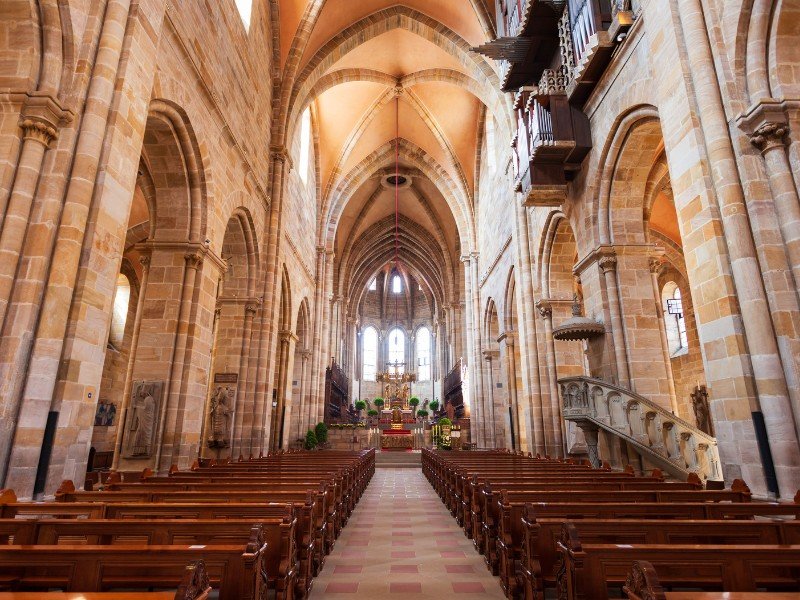
1. Explore Bamberg Cathedral
Bamberg Cathedral stands tall with its Romanesque architecture and Gothic influences, offering a glimpse into Bamberg’s rich history. Inside, visitors can marvel at the Bamberg Horseman statue and the tomb of Pope Clement II. The cathedral’s towering structure dominates the skyline, providing a serene atmosphere for reflection. It’s also a great spot for panoramic city views from the surrounding square.
- Best for: History enthusiasts and architecture admirers.
- Tip: Visit early in the day to avoid crowds.
- Highlight: The Bamberg Horseman statue, a mysterious relic.
2. Visit the Old Town Hall (Altes Rathaus)
The Old Town Hall is one of Bamberg’s most iconic landmarks, perched in the middle of the Regnitz River. Legend has it that the citizens built the town hall on an artificial island when denied land by the bishop. Its exterior features stunning frescoes, and inside you can find the Ludwig Collection of porcelain. The bridge nearby offers fantastic photo opportunities.
- Best for: Art lovers and architecture buffs.
- Tip: Take photos from Obere Brücke for the best angle.
- Highlight: The unique location and vivid frescoes.
3. Stroll Through Little Venice
Little Venice is a charming district of former fishermen’s houses along the Regnitz River, with its picturesque facades providing a quaint, idyllic view. The area is perfect for a leisurely stroll or a relaxing boat ride in the summer months. Lush greenery and flowers line the riverside, creating a peaceful retreat from the city’s busier areas. The best time to visit is during the warmer months when the area truly comes to life.
- Best for: Leisurely strolls and scenic boat rides.
- Tip: Visit early morning to avoid crowds.
- Highlight: The fishermen’s houses and river views.
4. Discover the New Residence (Neue Residenz)
The Neue Residenz boasts over 40 lavish rooms once home to Bamberg’s prince-bishops. Highlights include the impressive Imperial Hall, with its ornate ceiling paintings, and the Rose Garden, offering stunning panoramic views of the city. The palace’s rich decor and history transport visitors back to Bamberg’s royal past. In the summer, the garden blooms with vibrant roses, making it an excellent spot to relax and take in the scenery.
- Best for: History buffs and garden enthusiasts.
- Tip: Visit in spring or summer for the full rose garden experience.
- Highlight: The stunning views from the Rose Garden.
5. Enjoy a Pint of Rauchbier
Rauchbier, Bamberg’s famous smoked beer, offers a distinct flavor that’s been brewed in the city for centuries. Schlenkerla and Spezial are two traditional breweries where you can sample this unique beer, known for its smoky taste. The rich flavor pairs perfectly with local Franconian dishes like Schäufele or sausages. It’s a must-try for beer lovers visiting Bamberg.
- Best for: Beer aficionados and culinary adventurers.
- Tip: Pair it with a hearty Franconian dish for the best experience.
- Highlight: The bold, smoky flavor of Rauchbier.
6. Tour the Michaelsberg Abbey
Sitting atop one of Bamberg’s seven hills, the Michaelsberg Abbey offers stunning views over the city. Though the abbey church is under renovation, visitors can still enjoy the surrounding gardens and the Franconian Brewery Museum. The museum provides an in-depth look into the region’s rich brewing history. It’s a peaceful retreat and an insightful visit for anyone interested in Bamberg’s beer culture.
- Best for: History lovers and beer enthusiasts.
- Tip: Visit the Franconian Brewery Museum for a unique experience.
- Highlight: The panoramic views from the Michaelsberg Abbey grounds.
7. Hike Up to Altenburg Castle
Altenburg Castle, the highest of Bamberg’s seven hills, offers breathtaking views and a deep dive into history. The castle dates back to the 12th century and has been beautifully preserved. The hike to the top takes you through scenic forests, rewarding you with panoramic vistas and a cozy castle restaurant to rest and enjoy a meal. It’s a great activity for those looking to combine history with nature.
- Best for: Outdoor enthusiasts and history lovers.
- Tip: Wear comfortable shoes for the hike up.
- Highlight: The stunning panoramic views of Bamberg.
8. Experience Bamberg’s Festivals
Bamberg’s festivals are a vibrant showcase of its local culture, from the cozy Christmas markets to the lively Sandkerwa festival in August. Sandkerwa is a must-see event, with beer stalls, boat races, and live music filling the streets. These festivals are a perfect opportunity to mingle with locals and enjoy traditional Franconian hospitality. The festive atmosphere truly brings the city to life.
- Best for: Festival-goers and cultural explorers.
- Tip: Book accommodation early during festival seasons.
- Highlight: The lively and traditional Sandkerwa festival.
9. Visit the Historical Museum Bamberg
Located in the Old Court (Alte Hofhaltung), the Historical Museum Bamberg offers a comprehensive look at the city’s past. The museum features artifacts ranging from prehistoric finds to medieval art and modern exhibitions. The building itself is a piece of history, providing the perfect backdrop for exploring Bamberg’s heritage. It’s a fascinating journey through time for history enthusiasts.
- Best for: History and art enthusiasts.
- Tip: Allow 1-2 hours to fully explore the museum.
- Highlight: The beautiful Alte Hofhaltung building and its exhibits.
10. Take a Guided Tour of the City
Explore Bamberg’s rich history and hidden gems by joining a guided city tour. From general walks through the Old Town to themed tours focused on beer, ghosts, or architecture, there’s something for everyone. Guided tours provide insights and stories you might miss while wandering alone. It’s an excellent way to deepen your understanding of this historic city.
- Best for: First-time visitors and history buffs.
- Tip: Choose a themed tour that aligns with your interests.
- Highlight: Learning the fascinating history of Bamberg from experts.
11. Relax in Hain Park
Hain Park is a beautiful urban retreat along the banks of the Regnitz River, offering a peaceful escape from Bamberg’s bustling city life. With shaded walking paths, playgrounds, and plenty of picnic spots, it’s perfect for a relaxing afternoon. The park is particularly stunning in autumn when the leaves turn vibrant shades of red and gold. Whether you’re out for a jog or a quiet stroll, the park’s tranquil atmosphere provides a perfect respite.
- Best for: Families and nature lovers.
- Tip: Visit during fall for the best foliage views.
- Highlight: The scenic walking paths along the Regnitz River.
12. Explore the Bamberg Symphony Orchestra
The Bamberg Symphony Orchestra is renowned for its exceptional performances, offering a world-class musical experience in the city. Concerts are held in the Bamberg Concert Hall, an acoustic marvel that enhances every note. Attending a performance is a must for music lovers looking to experience Bamberg’s rich cultural scene. It’s a fantastic way to spend an evening immersed in the beauty of classical music.
- Best for: Music enthusiasts and cultural explorers.
- Tip: Book tickets in advance, as performances sell out quickly.
- Highlight: The superb acoustics of the Bamberg Concert Hall.
13. Kayak on the Regnitz River
Rent a kayak and paddle down the Regnitz River for a unique way to experience Bamberg’s historical charm. This leisurely activity allows you to see the city’s landmarks, including Little Venice, from a different perspective. It’s especially peaceful in the early morning or late afternoon when the river is calm, offering a tranquil escape. A sunset kayaking trip provides a stunning view of the city illuminated in golden hues.
- Best for: Adventure seekers and outdoor lovers.
- Tip: Try sunset kayaking for a magical experience.
- Highlight: Gliding past Little Venice by water.
14. Visit the Bamberg Witch Trials Memorial
The Bamberg Witch Trials Memorial is a poignant reminder of a dark period in the city’s history during the 17th century when hundreds of people were accused of witchcraft. The memorial is a simple, thought-provoking space that honors the memory of the victims. It serves as a reminder of the dangers of fear and hysteria in society. A visit to this site provides a moment of reflection amidst the city’s rich historical landscape.
- Best for: History buffs and reflective travelers.
- Tip: Combine with a visit to nearby historical sites.
- Highlight: The sobering history behind the witch trials.
15. Discover Franconian Switzerland
Just a short drive from Bamberg, Franconian Switzerland is a region of stunning natural beauty, known for its dramatic rock formations and lush forests. It’s perfect for outdoor activities such as hiking, climbing, and exploring ancient caves. The area is dotted with charming villages and medieval castles, providing a blend of natural and cultural exploration. It’s a must-visit for those looking to escape into nature and enjoy the fresh air.
- Best for: Nature lovers and hikers.
- Tip: Visit in the spring or fall for optimal hiking conditions.
- Highlight: The region’s dramatic landscapes and medieval castles.
16. Sample Local Franconian Cuisine
Bamberg is a haven for foodies, with its hearty Franconian cuisine offering a true taste of the region. Be sure to try Schäufele (pork shoulder), Blaue Zipfel (bratwurst in vinegar), and locally caught carp. These traditional dishes are best enjoyed in one of Bamberg’s cozy taverns, often paired with a pint of Rauchbier. The flavors are robust, hearty, and full of local character.
- Best for: Food enthusiasts and cultural explorers.
- Tip: Pair your meal with a local Rauchbier for the full experience.
- Highlight: The hearty and rich Franconian dishes.
17. Wander Through the Gärtnerstadt
The Gärtnerstadt or Gardener’s Quarter is a unique neighborhood that showcases Bamberg’s history of urban gardening. Walking through its streets, you’ll see historical gardener’s homes, many of which still operate as market gardens today. The area’s agricultural traditions have been preserved for centuries, giving visitors a glimpse into Bamberg’s green history. It’s a peaceful and informative stroll through the city’s horticultural past.
- Best for: Garden enthusiasts and history lovers.
- Tip: Visit in spring to see the gardens in full bloom.
- Highlight: The charming market gardens and preserved gardener’s homes.
18. Attend a Beer Tasting Workshop
Dive deep into Bamberg’s beer heritage by participating in a beer tasting workshop. Learn about the city’s brewing traditions, discover the secrets behind the famed Rauchbier, and sample a variety of local brews. Workshops often take place in historic breweries, adding authenticity to the experience. It’s an educational yet fun activity for anyone curious about Bamberg’s beer-making expertise.
- Best for: Beer lovers and curious travelers.
- Tip: Try a variety of beer styles, not just the famous Rauchbier.
- Highlight: Learning the art of beer brewing from local experts.
19. Shop at the Grüner Markt
The Grüner Markt (Green Market) in Bamberg’s city center is a lively spot filled with stalls offering fresh local produce, flowers, and artisanal goods. It’s an ideal place to pick up some regional specialties or just enjoy the vibrant atmosphere of a traditional market. This bustling square is a great way to experience Bamberg’s local culture and pick up unique souvenirs. The fresh flavors and handmade crafts add a personal touch to any visit.
- Best for: Shoppers and market enthusiasts.
- Tip: Visit early to get the best produce and goods.
- Highlight: The fresh produce and local handmade crafts.
20. Visit the Bamberg Nativity Trail
During the holiday season, Bamberg transforms with the Nativity Trail, a tradition where nativity scenes are displayed across the city. The trail weaves through churches, shop windows, and public spaces, each scene intricately detailed. It’s a festive and heartwarming way to explore Bamberg in December, with many of the displays featuring handcrafted elements. This tradition brings a magical atmosphere to the city, perfect for getting into the holiday spirit.
- Best for: Holiday travelers and families.
- Tip: Follow the trail in the evening for a more enchanting experience.
- Highlight: The beautifully handcrafted nativity scenes spread throughout the city.

What To Eat and Drink in Bamberg, Bavaria
Bamberg is a city that is renowned for its delicious and distinctive cuisine, which features a unique blend of Bavarian and Franconian flavors.
Here’s a detailed guide to what you should eat and drink when visiting Bamberg, ensuring you savor the flavors that make this region unique.
1. Schäufele
A Franconian specialty, Schäufele is a slow-roasted pork shoulder that’s crispy on the outside and tender on the inside. Served with dark beer gravy, potato dumplings, and sauerkraut, it’s a must-try dish for meat lovers visiting Bamberg.
2. Rauchbier
Bamberg is world-renowned for its Rauchbier, or smoked beer, a brew that features a distinctive smoky flavor akin to that of smoked meats. This unique taste is achieved by malting barley over an open flame. Schlenkerla and Spezial are two of Bamberg’s most famous breweries offering authentic Rauchbier experiences.
3. Bamberger Hörnla
This small, horn-shaped potato is a local delicacy. The Bamberger Hörnla has a nutty flavor and can be enjoyed boiled, roasted, or in salads. It’s not just a side dish but a piece of Bamberg’s agricultural heritage.
4. Bamberger Zwiebel
The Bamberger Zwiebel is a large onion filled with minced meat, bread crumbs, and spices, then baked or roasted. Often served with a dark beer sauce, it perfectly encapsulates the hearty and rustic essence of Franconian cuisine.
5. Frankenwein
While Bamberg itself is more famous for its beer, the surrounding Franconia region produces some excellent wines. Dry Silvaner, Müller-Thurgau, and Bacchus whites are particularly noteworthy. Enjoying a glass of Frankenwein is a delightful way to complement a traditional Franconian meal.
6. Fränkischer Sauerbraten
A Franconian version of the German pot roast, typically made from beef (though sometimes pork or venison), marinated for days in a mixture of vinegar, water, and spices before being slow-cooked. The result is tender, flavorful, and often served with red cabbage and knödel (dumplings).
7. Knödel
These dumplings are a staple of the Franconian diet and can come in many forms, from potato to bread-based versions. They are often served as a side to hearty meat dishes or even in a sweeter variant with fruit fillings as a dessert.
8. Obatzda
A Bavarian cheese delicacy, Obatzda combines ripe Camembert with butter, beer, and spices to create a rich and creamy spread. It’s traditionally served with pretzels or rye bread and makes a perfect accompaniment to a cold pint of beer.
9. Kloß mit Soß
A simple yet comforting dish, “Kloß mit Soß” translates to “dumpling with sauce.” The dumplings are typically made from potatoes or bread, and the sauce can range from a rich gravy to a lighter broth, often featuring meat.
10. Lebkuchen
While more associated with Nuremberg, Bamberg also has a tradition of crafting Lebkuchen, a type of gingerbread that comes in various shapes and sizes. This sweet treat, especially popular during the Christmas season, is rich in spices and often coated with chocolate or sugar glaze.
11. Karpfen
Fish enthusiasts should try the Karpfen, or carp, a traditional dish particularly popular during the Christmas season. It can be prepared in various ways, but frying is the most common method, resulting in a crispy skin and tender meat.
12. Prinzregententorte
For dessert, indulge in a slice of Prinzregententorte, a Bavarian layer cake made with thin layers of sponge cake separated by chocolate buttercream. The cake is enrobed in a dark chocolate glaze, offering a decadent finish to any meal.
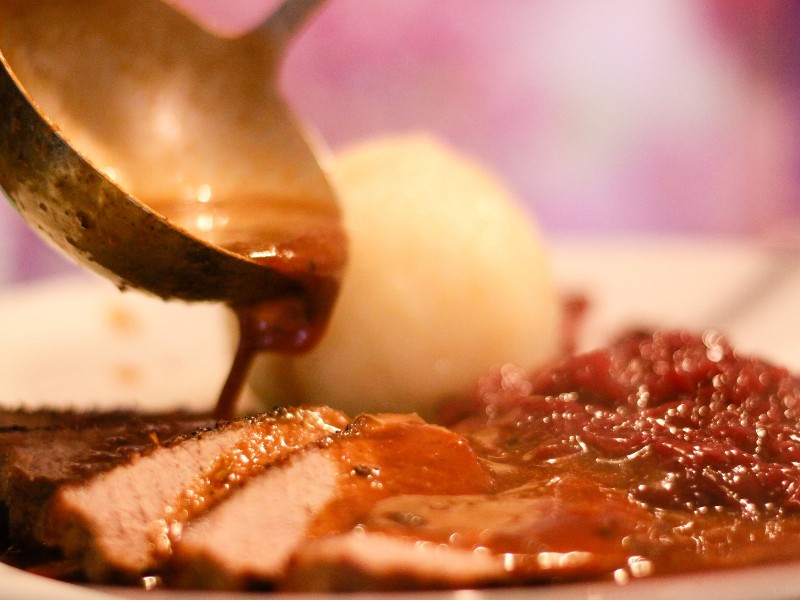
Top Restaurants In Bamberg, Germany
Here’s a guide to some of the top restaurants in Bamberg, each promising a unique dining experience.
1. Schlenkerla
- Tradition in Every Sip: Located in the heart of the old town, Schlenkerla is famed for its Rauchbier (smoked beer) and traditional Franconian dishes. Dining here is like stepping back in time, with a menu that celebrates local ingredients and recipes passed down through generations.
- Must-Try: The smoked beer-marinated pork shoulder, served with sauerkraut and dumplings, perfectly complements the brewery’s unique beers.
2. Restaurant Eckerts
- Where the Old Meets New: Situated on the banks of the Regnitz River, Eckerts combines modern dining with stunning views. The menu offers a contemporary take on regional classics, emphasizing fresh, local produce.
- Highlight: The Franconian beef cheek, slow-cooked and tender, showcases the restaurant’s commitment to elevating traditional flavors.
3. Pelikan
- Cozy and Inviting: Pelikan is a hidden gem, known for its intimate setting and exceptional service. The menu features seasonal dishes inspired by global cuisines, all prepared with a creative twist.
- Recommended Dish: The homemade pasta, which changes seasonally, is always a delight, showcasing the chef’s creativity and the freshest ingredients.
4. Café Abseits
- Casual Chic: This café and beer garden offers a relaxed atmosphere perfect for a casual meal or a drink. The menu includes a wide selection of vegetarian and vegan options, making it a hit among all types of food lovers.
- Specialties: Don’t miss their vegetarian Zwiebelkuchen (onion cake) and the selection of craft beers from around the world.
5. Kachelofen
- Franconian Charm: Kachelofen, in Bamberg’s Old Town, serves traditional Franconian cuisine in a cozy, rustic setting. The restaurant is named after its historic tiled stove, adding warmth and a welcoming ambiance.
- Franconian Classics: The Sauerbraten (marinated roast beef) is a standout, perfectly balanced with sweet and sour flavors and served with potato dumplings.
6. Messerschmitt
- Elegant Dining: Part of the Hotel Messerschmitt, this restaurant offers a refined dining experience with a menu that blends Franconian specialties with international influences. The elegant setting makes it ideal for a special occasion.
- Signature Dish: The truffle pasta, rich and flavorful, is a testament to the kitchen’s skill and attention to detail.
7. St. Erhard im Krug
- Farm to Table: This restaurant focuses on sustainable, locally sourced ingredients, offering a menu that changes with the seasons. The modern, airy interior complements the innovative dishes.
- Highlight: The tasting menu, which allows diners to sample the best of what’s in season, paired with excellent local wines.
8. Zum Sternla
- Oldest Tavern in Bamberg: Dating back to 1380, Zum Sternla offers a journey through Bamberg’s culinary history. The menu features hearty, traditional fare in one of the city’s most historic settings.
- Traditional Fare: The Bratwurst, grilled to perfection and served with sauerkraut, is a must-try, embodying the soul of Franconian cuisine.
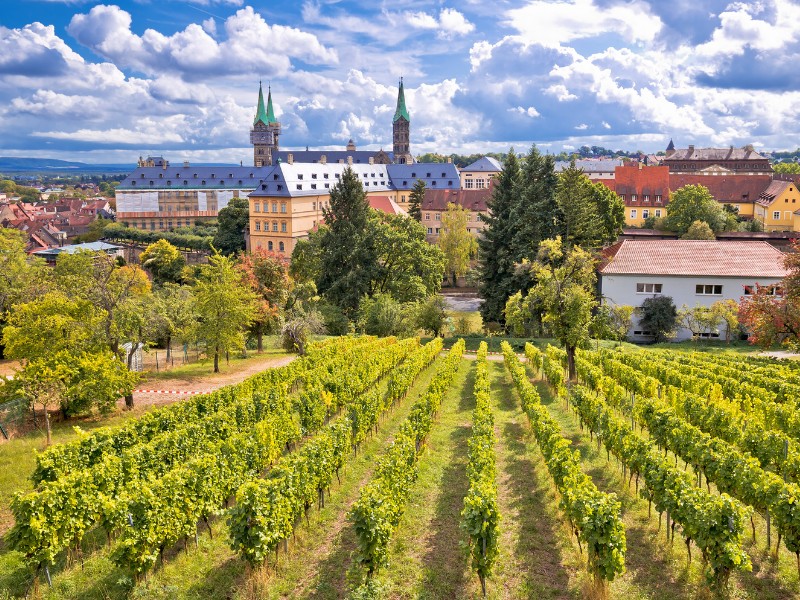
Tours For Visitors To Bamberg, Bavaria
Here’s a guide to some of the best tours in Bamberg, offering immersive experiences for every type of traveler.
1. Bamberg Old Town Walking Tour
- Dive into Bamberg’s rich history with a guided walking tour through its Old Town. These tours cover iconic landmarks such as the Bamberg Cathedral, Altes Rathaus (Old Town Hall), and the picturesque Little Venice area.
- Learn about Bamberg’s fascinating past, from its foundation in the 9th century to its importance as a center of the Holy Roman Empire.
2. Bamberg Brewery Tour
- Bamberg is famous for its unique Rauchbier (smoked beer) and vibrant brewery scene. Brewery tours offer a behind-the-scenes look at the brewing process, visits to traditional breweries, and, of course, beer tastings.
- Discover why Bamberg is often referred to as the beer capital of Franconia and sample some of the city’s best brews.
3. Bamberg Night Watchman Tour
- Experience Bamberg’s medieval charm after dark on a tour led by the Night Watchman. Dressed in traditional attire, the watchman guides visitors through the cobblestone streets, sharing eerie tales and legends of Bamberg by lantern light.
- This atmospheric tour provides a unique perspective on the city’s history and folklore.
4. Bamberg River Cruise
- Enjoy the scenic beauty of Bamberg from the water on a relaxing river cruise. These cruises offer stunning views of the city’s waterfront architecture and natural landscapes.
- A river cruise is a perfect way to see Bamberg from a different vantage point while learning about the city’s connection to the Regnitz and Main rivers.
5. Bamberg Culinary Tour
- Explore Bamberg’s culinary delights on a guided tour that introduces you to Franconian cuisine. Sample traditional dishes, visit local markets, and learn about the city’s food culture.
- From hearty bratwurst to sweet Lebkuchen (gingerbread), discover the flavors that make Bamberg a food lover’s paradise.
6. Bamberg Garden and Park Tour
- Bamberg’s gardens and parks are hidden gems, offering serene escapes within the city. Guided tours of these green spaces, including the Rose Garden at the New Residence, highlight the beauty and tranquility of Bamberg’s natural surroundings.
- Learn about the history and design of these gardens, which provide a peaceful contrast to the bustling city streets.
7. Bamberg Ghost Tour
- For those who enjoy a bit of mystery, Bamberg’s ghost tours delve into the city’s darker side, exploring haunted locations and telling tales of unexplained phenomena.
- Discover the legends that lurk in the shadows of Bamberg’s historic buildings and alleyways.
8. Bamberg UNESCO Heritage Tour
- Specifically designed to showcase Bamberg’s status as a UNESCO World Heritage site, these tours focus on the city’s architectural and cultural landmarks that have earned it global recognition.
- Expert guides explain the significance of Bamberg’s medieval urban layout and preserved structures, offering insights into the city’s heritage and conservation efforts.
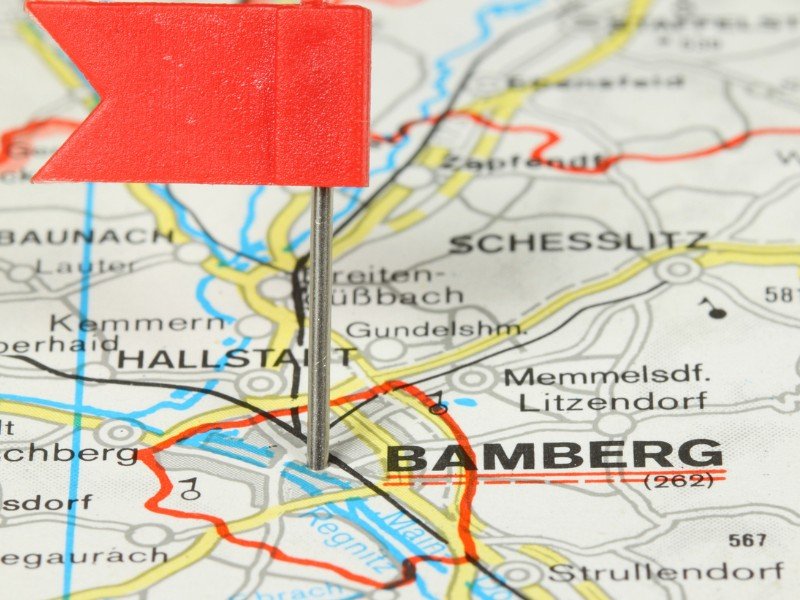
Bamberg Accommodations Guide: Hotels, Guesthouses and Hostels
Here’s a curated list of accommodations, from luxurious hotels to cozy hostels, each providing a unique gateway to exploring this medieval city.
Luxury Hotels
1. Welcome Hotel Residenzschloss Bamberg
- Nestled beside the banks of the Regnitz River, this luxurious hotel occupies a 17th-century palace. It combines historical elegance with modern comfort, offering guests a royal experience with spa facilities, gourmet dining, and exquisite rooms that echo Bamberg’s imperial past.
2. Hotel Villa Geyerswörth
- This charming hotel, comprising four interconnected buildings set around a lovely courtyard garden, blends Italian villa vibes with Franconian warmth. With its tasteful rooms, on-site restaurant serving local cuisine, and proximity to Bamberg’s historic center, it’s a sanctuary of sophistication.
Mid-Range Hotels
3. Hotel Nepomuk
- Set in the “Little Venice” area, Hotel Nepomuk offers the unique experience of staying in a half-timbered building over water. The hotel combines rustic charm with contemporary design, and its restaurant features riverside dining that’s both scenic and serene.
4. Altstadthotel Molitor
- Housed in a historic mill in the heart of the old town, Altstadthotel Molitor is a maze of comfort and tradition, with rooms decorated to reflect Bamberg’s heritage. Its central location makes it an ideal base for exploring the city by foot.
Budget Accommodations
5. Backpackers Bamberg – Little Venice
- Catering to budget travelers and backpackers, this hostel is celebrated for its friendly atmosphere, clean and comfortable rooms, and prime location close to major attractions. It’s a fantastic option for those who enjoy meeting fellow travelers.
6. Ibis Budget Bamberg
- Offering the reliability of the Ibis brand, Ibis Budget Bamberg provides straightforward, modern rooms at affordable prices. Situated a short walk from the city center, it ensures a comfortable stay without stretching your budget.
Guesthouses and B&Bs
7. Tandem Hotel
- This cozy, family-run hotel captures the essence of Bamberg’s hospitable spirit. Guests can enjoy beautifully appointed rooms and a delightful breakfast. The Tandem Hotel is particularly noted for its friendly service and excellent location.
8. Am Blumenhaus
- Conveniently located near Bamberg’s pedestrian zone, Am Blumenhaus is a charming bed and breakfast offering comfortable rooms with a homely feel. The warm and welcoming staff, along with a hearty breakfast, make for a pleasant stay.
Unique Stays
9. The Old Town Apartments
- For those seeking a home-away-from-home experience, The Old Town Apartments provide fully furnished accommodations dotted around Bamberg’s historic center. These apartments are perfect for longer stays or for travelers wanting a more local living experience.
10. Schlafstube Bamberg
- Combining the coziness of a B&B with the sociability of a hostel, Schlafstube Bamberg offers a unique stay in creatively decorated rooms. It’s a boutique choice for those looking for character, comfort, and a touch of artistic flair in their accommodation.
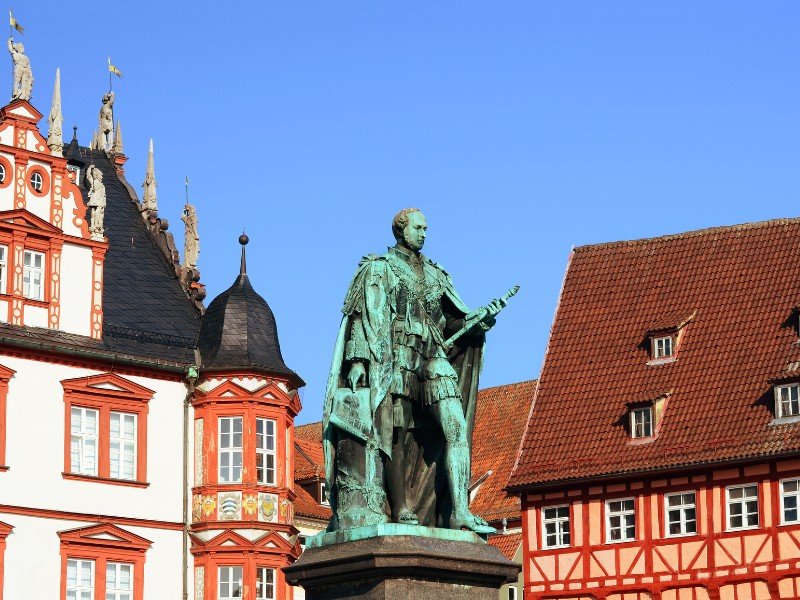
Day Trips From Bamberg, Bavaria, Germany
The region around Bamberg offers a wealth of destinations for memorable day trips. Here’s a curated list of day trips from Bamberg, each promising its own unique blend of attractions and experiences.
1. Nuremberg
Just an hour away by train, Nuremberg beckons with its medieval castle, historic old town, and poignant World War II history sites, including the Nazi Party Rally Grounds and Documentation Center. The city’s Christmas market is renowned worldwide, offering a festive experience in the winter months. Nuremberg’s museums, such as the Germanic National Museum, showcase rich collections spanning centuries of German culture and history.
2. Würzburg
Home to the UNESCO-listed Würzburg Residence, this city combines opulent baroque architecture with the charm of Franconian wine country. The fortress Marienberg offers panoramic views of the city and the Main River. Würzburg’s old bridge, adorned with statues of saints, provides a picturesque spot for enjoying a glass of local wine. The city is also a gateway to the Romantic Road, leading travelers through quintessentially German landscapes and towns.
3. Rothenburg ob der Tauber
A two-hour drive from Bamberg, Rothenburg is like stepping into a fairy tale, with its well-preserved medieval old town, fortified walls, and cobblestone streets. The Night Watchman’s Tour offers an entertaining and informative way to learn about the town’s history. Rothenburg’s Christmas Museum is a delight for visitors of all ages, celebrating the holiday’s traditions year-round. The town is a photographer’s dream, especially the iconic view from Plönlein.
4. Regensburg
Situated along the Danube River, Regensburg boasts a stunning medieval center that has earned it UNESCO World Heritage status. Its ancient stone bridge, Cathedral of St. Peter, and the historic Old Town with its narrow lanes and courtyards are must-visit landmarks. Regensburg’s Sausage Kitchen, dating back to the 12th century, offers a taste of traditional Bavarian cuisine. The city’s vibrant cultural scene, with festivals and events throughout the year, adds to its appeal.
5. Bayreuth
Famous for its annual Richard Wagner Festival, Bayreuth attracts music lovers from around the globe to its opulent Festspielhaus. The Margravial Opera House, another UNESCO site, astonishes visitors with its baroque beauty. Bayreuth’s Eremitage, a complex of gardens and palaces, provides a peaceful retreat. The city’s unique museums, including the Franconian Brewery Museum, offer insights into local traditions and history.
6. Coburg
Less than an hour’s drive from Bamberg, Coburg is crowned by the imposing Veste Coburg fortress, offering vast collections of art and artifacts. The town’s historic marketplace, surrounded by traditional buildings and cozy cafés, is perfect for leisurely exploration. Coburg’s connection to the British royal family is celebrated in the Schloss Ehrenburg and its gardens. The town’s Samba Festival in July transforms Coburg into a vibrant carnival of music and dance.
7. Franconian Switzerland
This region, known for its picturesque landscapes of rolling hills, rocky formations, and castle ruins, is a paradise for outdoor enthusiasts. Activities include hiking, rock climbing, and exploring cave systems. The area is dotted with traditional breweries, making it an excellent place for beer tasting amidst nature. Franconian Switzerland’s small, charming villages, like Pottenstein and Gößweinstein, offer a glimpse into rural Bavarian life.
8. Erlangen
Famous for its Baroque cityscape and as a hub of science and research, Erlangen presents a blend of intellectual vigor and architectural beauty. The Botanical Garden, associated with the University of Erlangen-Nuremberg, is a tranquil spot for relaxation. Erlangen’s Schlossgarten and Orangerie provide a historical backdrop for leisurely walks. The city’s lively beer culture, celebrated during the annual Bergkirchweih festival, is a draw for visitors.
9. Fichtel Mountains
For those seeking adventure in nature, the Fichtel Mountains offer hiking, skiing, and mountain biking. The region’s highest peak, Ochsenkopf, provides stunning views and a variety of outdoor activities year-round. Cultural attractions include the Luisenburg Rock Labyrinth and the Fichtel Mountain Museum. The area’s clear lakes, such as Fichtelsee, are perfect for summer swims in idyllic settings.
10. Bamberg’s Surrounding Countryside
For a leisurely day spent closer to Bamberg, the rolling hills and quaint villages of the surrounding countryside beckon. A bike ride or drive through this pastoral landscape reveals small breweries, traditional Franconian restaurants, and unspoiled nature. Local highlights include the Seehof Palace and its baroque garden. This relaxed excursion offers a taste of Bavaria’s rural charm, just a stone’s throw from Bamberg.
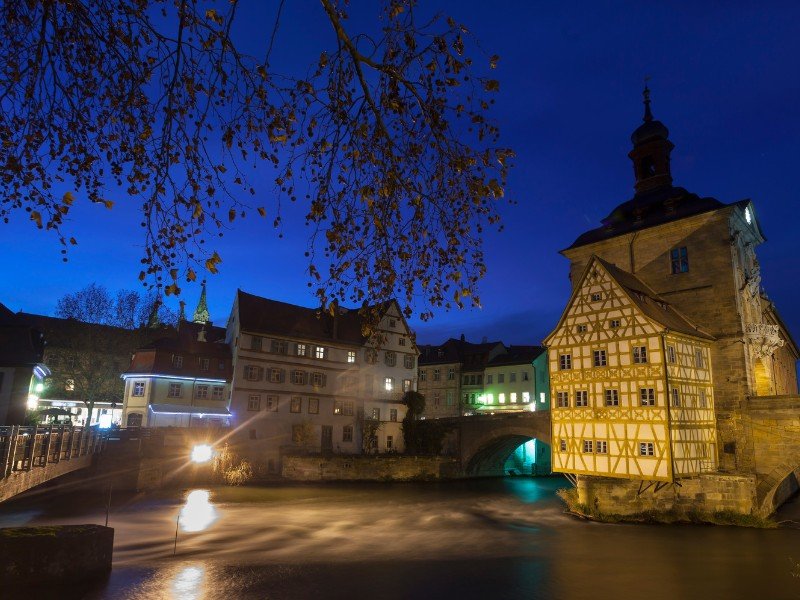
Bamberg Transportation Guide
Whether you’re exploring the city’s historic center or venturing into the scenic countryside, here’s a comprehensive guide to transportation in and around Bamberg.
Public Transportation in Bamberg
1. Buses
- Bamberg’s extensive bus network is operated by Stadtwerke Bamberg, covering the city and its suburbs efficiently. Buses run frequently, connecting major attractions, shopping areas, and residential neighborhoods. Tickets can be purchased from the driver, at ticket machines, or via the Stadtwerke Bamberg app. Day passes and group tickets offer economical options for visitors.
2. Night Buses
- For late-night travelers, Bamberg offers night bus services on Fridays, Saturdays, and before public holidays. These buses ensure safe and convenient transportation options during the hours when regular services have ceased.
Cycling in Bamberg
3. Bike Rentals
- Bamberg is a bike-friendly city with numerous cycling paths along the Regnitz River and throughout the historic center. Bike rental services are available at various locations, offering an eco-friendly and enjoyable way to explore the city. Stations around Bamberg allow for easy pick-up and drop-off, catering to both short-term and long-term rental needs.
Train Services
4. Regional and Long-Distance Trains
- Bamberg is well-connected by train, with the main station (Bamberg Hauptbahnhof) serving as a hub for regional and long-distance Deutsche Bahn services. Trains offer direct connections to major cities like Nuremberg, Munich, and Berlin, making Bamberg an accessible destination for travelers. The Bayern Ticket is a cost-effective option for exploring Bavaria via regional trains.
Driving and Parking
5. Car Rentals
- Visitors who prefer to drive can find several car rental agencies in Bamberg. Driving offers flexibility for exploring the Franconian countryside and visiting nearby towns and villages. However, it’s important to note that the historic center has limited access for vehicles and parking can be scarce.
6. Parking
- For those driving into Bamberg, the city provides several parking options including street parking and parking garages. Parking guidance systems help locate available spaces. It’s advisable to park outside the pedestrianized old town and explore the city center on foot or by public transport.
Walking in Bamberg
7. Pedestrian Zones
- Much of Bamberg’s charm can be best experienced on foot, especially within the UNESCO-listed old town. Pedestrian-friendly zones make it easy to wander through historic streets, discover hidden courtyards, and enjoy the city’s lively squares.
Taxis and Ride Services
8. Taxis
- Taxis offer convenient transportation within Bamberg, especially outside the operating hours of public transport. Taxi stands are located at key points in the city, including Bamberg Hauptbahnhof and central plazas. Ride services like Uber are less common, but local taxi companies can be called directly or hailed on the street.
Accessibility
9. Accessibility in Public Transport
- Bamberg is committed to providing accessible transportation options. Buses and trains are equipped to accommodate travelers with mobility challenges, ensuring that the city’s attractions are accessible to all.
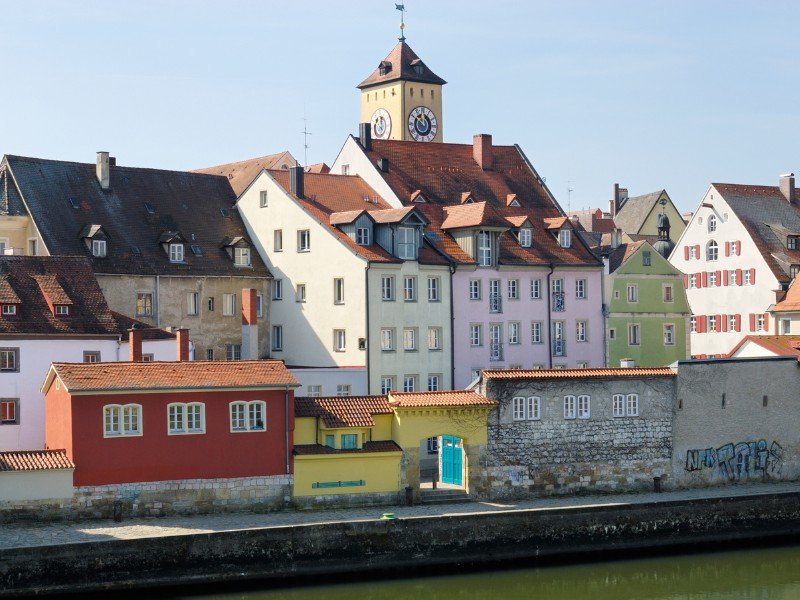
Where To Visit After Your Trip To Bamberg?
Here’s a curated list of places to visit after Bamberg, each offering its unique attractions and experiences.
1. Nuremberg
Just an hour away, Nuremberg’s imperial castle, WWII historical sites, and vibrant market squares offer a deep dive into Bavarian and German history. The city’s Documentation Center provides insightful perspectives on its darker past, while the Christkindlesmarkt is one of Germany’s oldest Christmas markets. Nuremberg’s blend of medieval charm and modern vibrancy makes it an essential stop.
2. Rothenburg ob der Tauber
Step into a fairy tale in Rothenburg ob der Tauber, a well-preserved medieval town on the Romantic Road. Its cobblestone streets, fortified walls, and picturesque buildings are perfect for leisurely exploration. The Night Watchman’s Tour offers a unique evening stroll through history. Rothenburg is also famous for its Christmas shop, open year-round.
3. Würzburg
Würzburg invites with the Residenz, a UNESCO World Heritage site, showcasing baroque architecture and the largest ceiling fresco in the world. The city is also the gateway to the Franconian Wine Country, offering tastings and vineyard tours. The Marienberg Fortress provides panoramic views of the city and the Main River. Würzburg’s vibrant student population adds a lively atmosphere to its historic streets.
4. Munich
The capital of Bavaria, Munich, is known for its Oktoberfest, beer gardens, and the Marienplatz with its famous Glockenspiel. The city’s museums, such as the Deutsches Museum, offer vast collections spanning science, technology, and art. Munich is also a gateway to the Bavarian Alps, making it an ideal base for outdoor adventures. Its blend of cultural richness and lively traditions offers something for every traveler.
5. Regensburg
Regensburg, with its medieval Old Town and stunning Gothic Cathedral, stands as a testament to its status as a UNESCO World Heritage site. The Stone Bridge, dating back to the 12th century, and the historic Wurstkuchl (Sausage Kitchen) are must-visits. The city’s vibrant cultural scene is highlighted by classical concerts at the Palace of Thurn and Taxis. Regensburg’s location on the Danube makes river cruises a popular activity.
6. Frankfurt
As a major financial hub, Frankfurt offers a skyline of skyscrapers unique in Germany, earning it the nickname “Mainhattan.” The city’s museums along the Museum Embankment cover art, history, and natural science. The historic Römerberg square and the Goethe House provide insights into Frankfurt’s past. Frankfurt serves as a central point for exploring the wider Rhine-Main region.
7. Bavarian Alps
For nature enthusiasts, the Bavarian Alps are a paradise of stunning landscapes, hiking trails, and winter sports. Destinations like Garmisch-Partenkirchen and the fairy-tale Neuschwanstein Castle are highlights. The region offers activities year-round, from skiing and snowboarding in the winter to mountain biking and paragliding in the summer. The scenic beauty and outdoor adventures make it a perfect counterpoint to city explorations.
8. Heidelberg
Famous for its romantic castle ruins overlooking the Neckar River, Heidelberg captures the heart with its idyllic setting and historic university town vibe. The Philosophers’ Walk offers breathtaking views of the city and the surrounding valleys. Heidelberg’s old town is a treasure trove of baroque architecture and charming cafes. The city is also known for its vibrant arts scene and literature history.
9. Bamberg’s Franconian Switzerland
Just a short drive from Bamberg, Franconian Switzerland offers a landscape of rocky outcrops, deep valleys, and quaint villages. It’s renowned for its hiking trails, cave explorations, and traditional breweries dotting the countryside. Castles like Pottenstein and Gößweinstein add historical intrigue to natural beauty. It’s an area that epitomizes the rural charm of Franconia.
10. Leipzig
Leipzig is noted for its rich musical heritage, closely associated with Bach, Wagner, and Mendelssohn. The city boasts a vibrant arts scene, innovative culinary offerings, and historical sites like the St. Thomas Church and the Battle of the Nations Monument. Leipzig’s revitalized industrial spaces, such as the Spinnerei, now host galleries and cultural venues. It’s a dynamic city where history and contemporary culture merge seamlessly.

Essential Questions About Visiting Bamberg, Germany: Practical Trip-Planning Answers, Beer-Lover Tips & First-Timer Advice
How many days should I spend in Bamberg for a first visit?
Two days. That’s the sweet spot if you want to see the highlights without speed-walking your way through a UNESCO postcard. With two full days, you can cover the cathedral area, the Old Town Hall, Little Venice, the New Residence and rose garden, plus leave time for a relaxed beer garden or two and a proper Franconian meal. If you’re a beer nerd or a slow traveler, add a third day for brewery hopping and a mellow day trip into the countryside.
Is Bamberg worth a day trip from Nuremberg or Munich?
Absolutely. From Nuremberg, Bamberg is an easy, low-stress day trip and one of the best “big reward for small effort” stops in Bavaria. From Munich, it’s a longer haul, so I’d only do it as a day trip if your schedule is tight and you really want medieval Old Town vibes and smoked beer in the same afternoon. If you can spare a night, Bamberg gets even better once the day-trippers thin out.
What is the best time of year to visit Bamberg?
It depends. Late spring through early fall is the easiest window for long walking days, river scenery, beer gardens, and that warm golden light that makes the Old Town look unreal. Summer brings the most energy and events, but also the biggest crowds. If you like a calmer atmosphere, aim for May, September, or early October when the weather is still friendly and the city feels more local than tour-busy.
What should I not miss in the Old Town if my time is limited?
If you only have a few hours, focus on a tight triangle: the Bamberg Cathedral area, the Old Town Hall bridging the Regnitz, and a stroll through the riverside lanes near Little Venice. That mini-route gives you the city’s grand history, its most iconic photo spot, and its soft, romantic waterfront charm. Add a quick stop for a Rauchbier and you’ll feel like you got the Bamberg “greatest hits” without rushing too hard.
Where is the best area to stay in Bamberg?
For most visitors, staying in or near the Old Town is the easiest win because you can walk everywhere and slip out early for photos before the streets fill up. If you want quieter nights (or better value), look for spots just outside the historic core with good bus access or an easy 15–20 minute walk in. I’m a fan of choosing location over luxury here—Bamberg is the kind of city you enjoy most when you can wander out the door and immediately be in the medieval atmosphere.
Do I really need to try Rauchbier, and where should I start?
Yes. Even if you think you won’t like smoky flavors, Bamberg’s Rauchbier is part of the city’s identity, and trying it is like tasting a living piece of local history. Start with a small pour so you can ease into the flavor, and pair it with classic Franconian food—smoke plus hearty meat-and-dumpling comfort makes a lot more sense together. If one brand feels too intense, try another; the smoke level and balance can vary from brewery to brewery.
Is Bamberg a good destination for foodies who don’t eat pork?
Yes. While pork-heavy Franconian classics get most of the spotlight, you can still eat very well if you don’t do pork. Look for trout or carp specialties, seasonal vegetable dishes, dumplings served with mushroom sauces, cheeses, and modern cafés that lean international or vegetarian-friendly. The key is to scan menus a bit more intentionally and treat Bamberg as a “regional cuisine with options” city, not a one-note meat festival.
How easy is Bamberg to explore on foot?
Very easy. The historic center is compact, scenic, and built for slow wandering, so you can tackle most major sights on foot over one or two days. Expect cobblestones, a few gentle hills, and lots of “wait, I need a photo of this” moments. Comfortable walking shoes are the single best planning decision you can make here.
What is the easiest way to get around without a car?
Buses plus walking is the simple formula. The Old Town is best on foot, while buses help you reach places like Altenburg Castle or neighborhoods outside the center without burning your legs. Taxis are useful late at night or if you’re traveling with anyone who can’t handle longer walks, but most travelers won’t need a car for a standard Bamberg visit.
Should I rent a bike in Bamberg?
It depends. If you enjoy cycling, Bamberg can be a fun place for riverside rides and for reaching green spaces and quieter pockets beyond the Old Town. That said, the historic lanes can be busy and narrow, so biking works best as a supplement rather than your primary way to see the core sights. For many first-timers, walking is still the more relaxed and photogenic choice.
Is Bamberg a good base for day trips?
Absolutely. Bamberg sits in a great patch of Bavaria/Franconia for easy rail or short-drive adventures. You can reach bigger cities for museums and history, or head into the countryside for hiking, caves, castle ruins, and smaller brewery towns. If you like having one home base and branching out, Bamberg is a smart pick.
Is Bamberg family-friendly with small kids?
Yes. The city’s parks, river walks, and open squares make it surprisingly easy with children, and the compact Old Town reduces the “are we there yet?” factor. The main challenge is stroller navigation on cobblestones and tight medieval lanes, so a compact stroller or carrier helps. Plan in snack breaks and small “reward stops,” and Bamberg becomes a relaxed, low-drama family city.
Is Bamberg accessible for travelers with mobility limitations?
Not really—at least not without planning. The Old Town’s age is part of the charm, but it also means uneven surfaces, cobblestones, and occasional stairs. The good news is that you can still enjoy a lot of Bamberg with a slower route plan, strategic taxi use, and choosing accommodations with elevators close to main routes. If accessibility is a priority, I’d build your days around fewer, more meaningful stops rather than trying to tick off every landmark.
Is Bamberg safe at night, and are there common scams?
Yes, it’s generally a safe city with a relaxed evening vibe, especially around the Old Town. Like anywhere, keep an eye on your belongings in crowded areas or during big events, and be cautious if someone’s trying an overly friendly distraction near tourist hotspots. The most common “risk” here is honestly just overindulging in beer and misjudging how far your hotel is on foot.
What are some easy day trips from Bamberg?
You’ve got plenty of great options within easy reach. Nuremberg is a strong pick for big-history and museum days, while Würzburg offers baroque grandeur and wine-country energy. For a fairy-tale medieval vibe, Rothenburg ob der Tauber is a classic. And if you want nature plus small-town brewery culture, the Franconian Switzerland region is the local outdoor favorite.
Bamberg Travel Guide: Final Thoughts
Bamberg, nestled in the picturesque Franconia region of Bavaria, is a charming and historic city with a rich cultural heritage. With its quaint cobbled streets, stunning architecture, and scenic beauty, it offers visitors a delightful blend of old-world charm and modern-day conveniences.
This travel guide has provided a comprehensive overview of Bamberg, from its fascinating history and cultural landmarks to its delicious cuisine and world-renowned beer. Visitors can explore the city’s enchanting old town, with its well-preserved medieval and baroque architecture, visit the Bamberg Cathedral and Alte Hofhaltung palace, or stroll through the picturesque parks and gardens.
For those seeking a culinary adventure, Bamberg’s rich culinary heritage, from the traditional smoked beer to the famous Bamberg sausages, offers a feast for the senses. And for beer enthusiasts, Bamberg’s distinctive beer-making tradition, with its signature smoked beer, offers an unforgettable tasting experience.
Final Thoughts
In addition to the city’s many attractions, Bamberg is also a great base for exploring the surrounding Franconian countryside. Day trips to nearby attractions like the beautiful wine country, the stunning castles and palaces, or the scenic hiking trails are highly recommended.
To make the most of your stay in Bamberg, a range of accommodations is available, from luxury hotels to cozy guesthouses, ensuring that visitors can find a comfortable and convenient base for their travels.
Bamberg is a must-visit destination for those looking to immerse themselves in the rich culture, history, and natural beauty of Franconia. Whether you’re seeking a relaxing getaway or an adventure-filled holiday, this travel guide has provided you with all the information you need to plan your perfect trip to Bamberg.
Ode To Bamberg
In the heart of Franconia’s greenery, Lies a city of charm and history. Bamberg, with its cobbled streets and spires, Awaits travelers with all their desires.
Walk through the old town’s winding alleys, Marvel at the baroque and medieval galleries. The Bamberg Cathedral, a sight to behold, The Alte Hofhaltung, steeped in stories untold.
But it’s not just the history that’s in store, Bamberg’s cuisine, a culinary explore. From smoked beer to sausages divine, Savor the flavors, let your taste buds shine.
And let’s not forget the region’s pride, Bamberg’s beer, a national treasure inside. With its distinct smoky flavor and aroma, A beer lover’s dream, no drama.
Day trips to the countryside, a scenic delight, Wine country, castles, nature’s might. Experience Franconia’s beauty in full bloom, Bamberg, your perfect base to consume.
So pack your bags, and hit the road, Bamberg’s beauty, your senses will explode. A city of charm and history, Bamberg, a traveler’s mystery.
